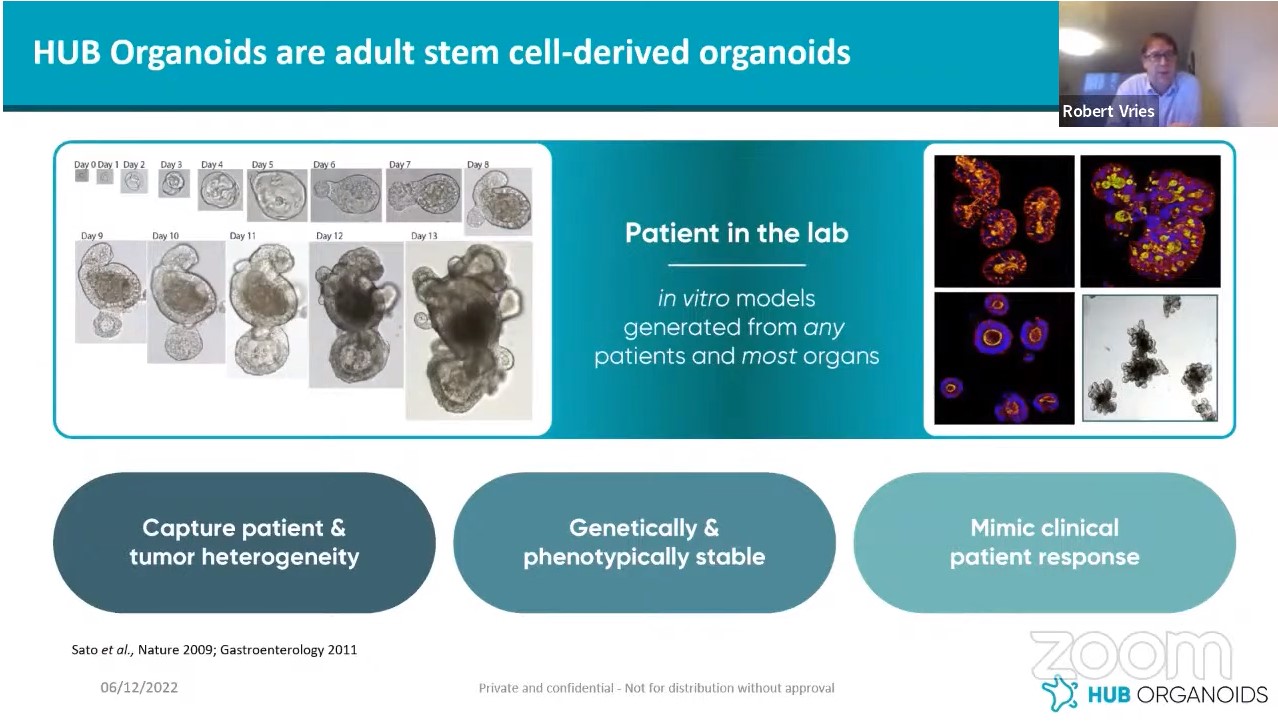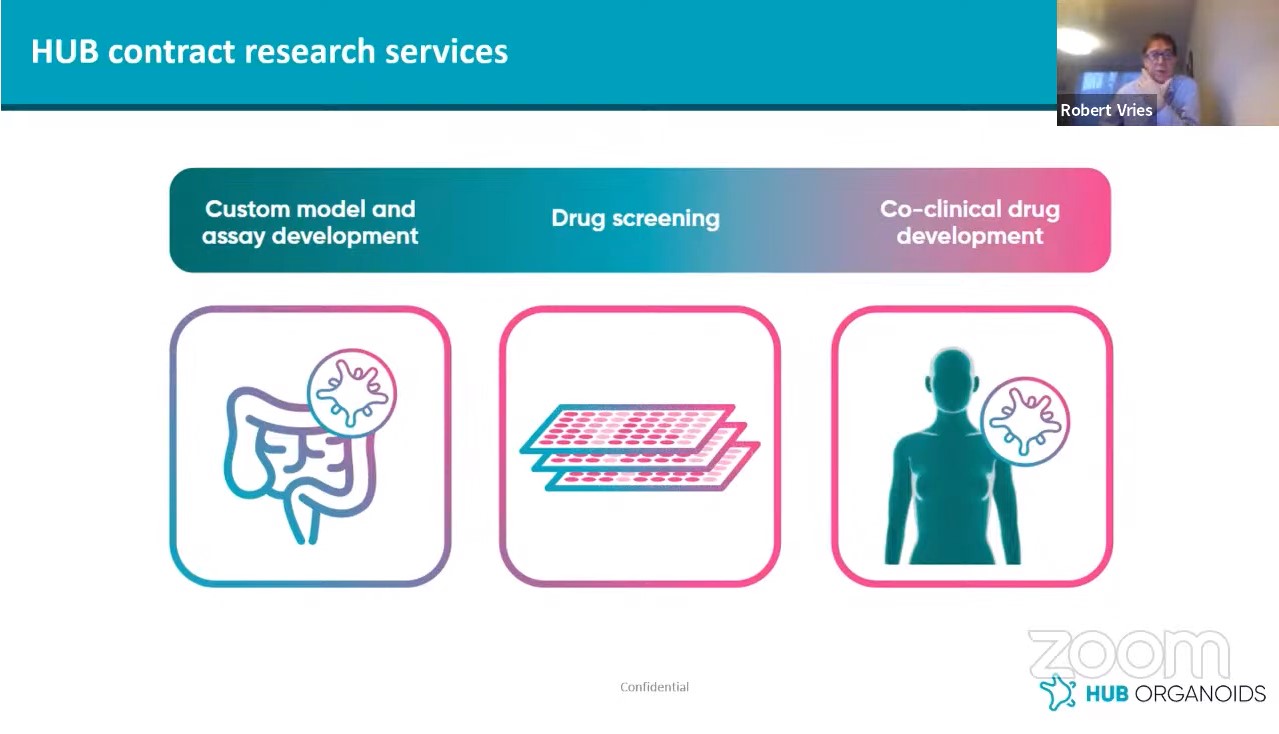ISSUES
Organoids to Bridge the Gap between Lab and Clinic by Dr. Robert Vries
Contents
(Stem Cell Therapy & Organoids Session 2)
Organoids to Bridge the Gap between Lab and Clinic
Robert Vries_Chief Executive Officer,HUB ORGANOIDS
Dr. Robert Vries gave a talk about HUB ORGANOID’s technology working on New Drug development which has led to quite a number of amazing drugs in immune oncology as the last feat of the discovery of trying to find new and effective drugs. Dr. Vries explained that going to the clinic, a lot of drugs unfortunately do not work on patients and one of the main things that is responsible are the models used pre-clinically to identify these drugs with poor representation of patients. He then proceeded to explain more about organoids in the field that change trying to get a patient model into the lab and the origin of the overall technology in the group of Hans Clevers working on stem cell and the group looked at the intestinal stem cells in the beginning in adult intestine. The identification of the stem cells, which is the intestinal adult stem cell also referred to as the LGR5 stem cell.
Image Sources: Zoom Presentation Screenshot by Dr. Robert Vries
These cells are responsible for renewing the intestine at a very fast renewing tissue, and with these adult stem cells, HANS Clevers lab was capable of making the first organoids. Understanding the stem cells and the stencils are the basis of a patient-derived organized system. Dr. Vries elaborated that with a single adult stem cell, coaching method allows the expansion of the stem cells and then with one critical characteristic in a genetically stable way. He continued to explain that there are drugs growing cell lines done for the last 50 to 60 years. He mentioned and gave credits to Doshi Rosado, who succeeded in developing a technology in which cell culture makes a lot of genetically stable and phenotypically stable expansion of the stem cells. With the structure they found, reminiscent of a normal intestinal epithelium, a polarized structure that has a basal ethical member and the cell interaction is a normal intestinal epithelium with stem cell compartment-like structures. The genetics of the expansion with these cells do remain stable genetically phenotypically stable functional models of patients. These organoids can be made from an entire basic problem so it's a very successful way of establishing a system, it doesn't work in one in a thousand patients but it actually works in the majority of patients. Dr. Vries explained that it can be healthy cells which can also be used in oncology or any other diseases. The ultimate technology started developing different models with a comparison but the end of the organic models to other models which started with the intestine, however this is an epithelial model that could generate these organs. After the discovery of stem cells in many of these organs, the development of an organoid model focused in a lot of ways on oncology. This doesn't only allow to grow cancer organized growth but to go relatively healthy cells for genetic diseases and infectious diseases. Making a model that benefits patient and developed most of the drugs that are in the clinic on biologically relevant models represent a mechanism that doesn't necessarily mean to be different type of clinical trial.
Image Sources: Zoom Presentation Screenshot by Dr. Robert Vries
Hans Clevers lab envisioned to make improvements in model systems that provide a platform for drug screening and develop customer and models specifically for industry. Hans Clever Lab already have license technology out to commercial parties to help implement model internally that leads to go into the scientific part about the key steps that indicate how to use organoid technology. Hans Clevers lab also considers conceptually using models in drug development and the key point is to do differently by implementing model system. Space is relevant in pre-clinical value development and screening to see any clinical relevance and a panel of bio specific antibiotic.
Dr. Vries explained that organoids are very useful and he then gave a comparison of the of antibody with the comparison of healthy organoids. Findings showing that this antibody, individuals had a very good response in the majority of patients treated. Having a develop an antibody specific for genetic and clinical background. Dr. Vries also shared that the most important thing is with the development timeline since it was very short. He concluded that industry must help people develop the compounds a lot faster and a lot cheaper. Finally, Dr. Vries showed an application cystic fibrosis which is particularly interesting. He mentioned that it was one of the first diseases before oncology that could be shared with direct patient relevance for organoids. As cystic fibrosis disease for lung is also affecting bankers and intestines, etc. It is a genetic disease which in Europe has about 2,000 different mutations and therefore, makes it relatively difficult to treat because both from a regulatory perspective needing clinical data on all these different mutations before getting a page a drug approved. Finally, Dr. Vries shared some results and a newer model at immune oncology which by specific antibodies based in the right T cells generating two more organoids and healthy organs of the same patient. HUB ORGANOID wants to change a drug development with a model system that memory based in the lab which is the main goal and they can derive a pre-clinical model from basically any Basin in the clinic. They connect the clinical site and the pre-clinical side of treatment of patients together and that allows pre-clinical easy, high throughput lab results on patients and constantly making clinical comparison. He ended emphasizing that these are relevant for clinical results in the development of new treatments and new models.


